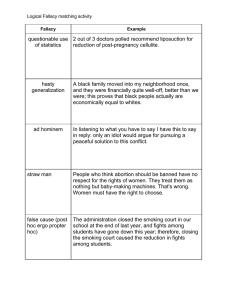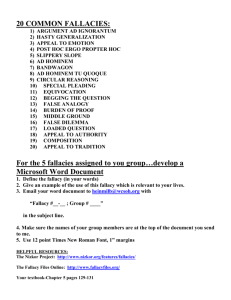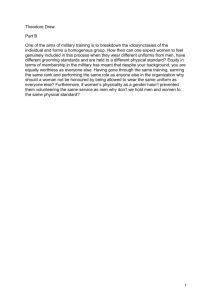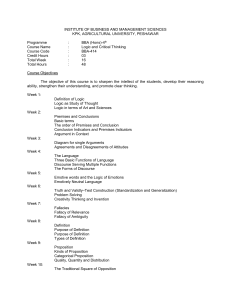An Introduction to Logic & Logical Fallacies Beginning Composition
advertisement
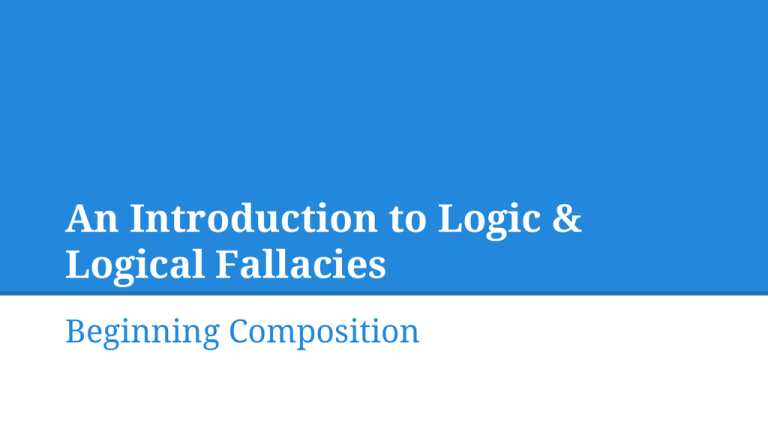
An Introduction to Logic & Logical Fallacies Beginning Composition Logic Logic is concerned with the principles of correct reasoning. People who learn logical thinking are better able to tell whether or not a conclusion follows from a set of statements or assumptions. An Introduction to Logic: from Monty Python and the Holy Grail What logic do the peasants and Sir Bedevere use to decide whether or not to burn the suspected witch? Evaluate their reasoning--should they burn this woman or not? Why? Syllogism Examples: A syllogism is All good students should get made up of a financial aid. (MAJOR) MAJOR PREMISE, Sarah is a good student. a MINOR (MINOR) Therefore, Sarah should get PREMISE, and a financial aid. (CONCLUSION) CONCLUSION. If both premises Some North Americans are tall. are true, the All Canadians are North conclusion is Americans. Some Canadians are tall. true. Practice with Syllogisms Label the MAJOR and MINOR premises in these syllogisms, as well as their CONCLUSIONS. All men are mortal. Socrates is a man. Therefore, Socrates is mortal. All jewelry is expensive. Some rings are jewelry. Some rings are expensive. All zebras have stripes. Some animals are zebras. Some animals have stripes. Complete these syllogisms with the CONCLUSION that necessarily follows from these premises. All mammals have hair. No reptiles have hair. Conclusion: Some Americans are Republicans. All Republicans are conservatives. Conclusion: All bananas are fruit. All fruit is good. Conclusion: Logical Fallacies Sometimes you will encounter arguments in which writers attack the opposition’s intelligence or patriotism and base their arguments on questionable (or even false) assumptions. As convincing as these arguments can sometimes seem, they are not valid because they contain fallacies--inaccurate or intentionally misleading arguments. Learning about some of these fallacies should help you recognize them in others’ writing and avoid them in your own writing. Ad Hominem (attack the person) An ad hominem argument attack the character of a person rather than the claim s/he makes. Examples: “Of course you would say marketing serves a valuable purpose; you work in marketing.” “You drank alcohol while underage, so we won’t accept your technical recommendations.” “I just don't trust people who dress like that; they should take pride in their appearance and not go around ungroomed if they want to be taken seriously!” Non Sequitur (It Does Not Follow) The non sequitur fallacy occurs when a conclusion does not follow from the premises. It is often supported by weak or irrelevant evidence--or no evidence at all. Examples: Megyn drives an expensive car, so she must be earning a lot of money. Gangs, drugs, and extreme violence plague today’s prisons. The only way to address this issue is to release all non-violent offenders as soon as possible. Recently, the polar ice caps have thickened, and the temperature of the oceans has stabilized. Obviously, the earth is healing itself. We don’t need to do more to control global warming. Circular Reasoning/Begging the Question Begging the Question (or circular logic) happens when the writer presents an arguable point as a fact that supports the argument. This error leads to an argument that goes around and around, with evidence making the same claim as the proposition. Because it is much easier to make a claim than to support it, many writers fall into this trap. Example: "These movies are popular because they make so much money. They make a lot of money because people like them. People like them because they are so popular." The argument continues around in the logical circle because the support assumes that the claim is true rather than proving its truth. Hasty Generalization A hasty Examples: generalization Pauline Kael, a film critic, said in 1972, about Richard Nixon being elected: occurs when “How can that be? No one I know someone reaches voted for Nixon!” a conclusion based My Honda broke down. Hondas are on too little junk. evidence. Three Congressional representatives Also called have had affairs. Therefore, jumping to a politicians are adulterers. conclusion. Slippery Slope Slippery Slopes suggest that one step will inevitably lead to more, eventually negative steps. While sometimes the results may be negative, the slippery slope argues that the descent is inevitable and unalterable. Stirring up emotions against the downward slipping, this fallacy can be avoided by providing solid evidence of the eventuality rather than speculation. Example: "If we force public elementary school pupils to wear uniforms, eventually we will require middle school students to wear uniforms. If we require middle school students to wear uniforms, high school requirements aren’t far off. Eventually even college students who attend state-funded, public universities will be forced to wear uniforms." Bandwagon Appeals (ad populum) Bandwagon Appeals (ad populum) try to get everyone on board. Writers who use this approach try to convince readers that everyone else believes something, so the reader should also. The fact that a lot of people believe it does not make it so. Example: "Fifty million Elvis fans can’t be wrong!" Of course they can. The merit of Elvis is not related to how many people do or do not like him or his music. False Authority False Authority is a tactic used by many writers, especially in advertising. An authority in one field may know nothing of another field. Being knowledgeable in one area doesn’t constitute knowledge in other areas. Example: A popular sports star may know a lot about football, but very little about shaving cream. His expertise on the playing field does not qualify him to intelligently discuss the benefits of aloe. (false ethos) Faulty Analogy Faulty Analogies lead to faulty conclusions. Writers often use similar situations to explain a relationship. Sometimes, though, these extended comparisons and metaphors attempt to relate ideas or situations that upon closer inspection aren’t really that similar. Be sure that the ideas you’re comparing are really related. Also remember that even though analogies can offer support and insight, they can’t prove anything. Example: "Forcing students to attend cultural events is like herding cattle to slaughter. The students stampede in to the event where they are systematically ‘put to sleep’ by the program." While the analogy is vivid, the difference between cultural events and cattle slaughter is so vast that the analogy becomes a fallacy. Straw Man Straw Man is a tactic used by a lot of writers because they find it easier to refute an oversimplified opposition. Writers may also pick only the opposition’s weakest or most insignificant point to refute. Doing so diverts attention from the real issues and rarely, if ever, leads to resolution or truth. Example: The debate over drink machines centers around cost and choice. Opponents of the new drink machines bring up their location as an important issue. This insignificant point has little relevance to the actual issues. Post-Hoc Ergo Propter Hoc (After This, Therefore Because of This) A post hoc ergo Examples: propter hoc (or post I wore my purple sweater and my team hoc) fallacy occurs won against all the odds. I am going when someone to wear that sweater to every game. Roosters crow just before the sun rises. assumes that a Crowing roosters cause the sun to certain event is the rise. cause of an Bill purchases a new laptop and it unrelated effect works fine for months. After installing a new piece of software, he simply because the starts up the computer and it freezes. event happened The software must be the cause of first. the freeze. Either-Or An either-or Examples: You either support public fallacy occurs prayer in schools or you when a complex are an atheist. issue, which might Either you support have many everything that the arguable president proposes or you are not a patriot. solutions, is There are two clear choices: reduced to only cutting funding to two possible education, or increasing outcomes. our national debt.
